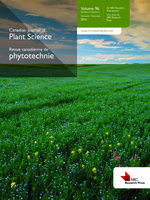Izydorczyk, M. S., McMillan, T., Bazin, S., Kletke, J., Dushnicky, L. and Dexter, J. 2014. Canadian buckwheat: A unique, useful and under-utilized crop. Can. J. Plant Sci. 94: 509-524. Buckwheat is a broad-leafed herbaceous annual plant, belonging to the genus Fagopyrum of the family Polygonaceae, the “smartweed” family, also called the buckwheat, rhubarb, or sorrel family. Although not a cereal, buckwheat on the whole resembles cereal grains; it is handled and processed like other cereals and officially listed among the 20 grains inspected and graded by the Canadian Grain Commission. In addition to starch (65-75% dwb) and proteins (13-14% dwb), buckwheat is a source of flavonoids (with rutin being the most distinctive), a group of polyphenolic compounds with a potential to inhibit lipoprotein oxidation and to reduce risk of cardiovascular diseases, and fagopyritols, another group of unique bioactive compounds first identified in buckwheat and associated with reduction of symptoms on non-insulin-dependent diabetes. Buckwheat proteins do not contain gluten, and buckwheat is regarded as an excellent alternative source of protein for individuals with celiac disease. Buckwheat is a particularly good dietary source of Zn, Cu, Mn and Mg. Buckwheat starch and dietary fibre constituents exhibit some distinctive physicochemical and functional properties. Despite the availability of several high-yielding, high-quality Canadian buckwheat cultivars and the well-established production of buckwheat on the Canadian prairies, buckwheat is found in relatively few food products manufactured in North America, and Canada remains largely an exporter of buckwheat rather than its processor. Buckwheat can be roller milled into various types of flours with variable composition and properties. Buckwheat milling fractions can be relatively easily incorporated in a variety of food products to improve their nutritional qualities and potential health benefits, but much more attention should be paid to the development and improvement of modern food processing techniques to improve the palatability and acceptability of buckwheat products.
How to translate text using browser tools
16 September 2013
Canadian buckwheat: A unique, useful and under-utilized crop
Marta S. Izydorczyk,
Tricia McMillan,
Sharon Bazin,
Jerry Kletke,
Len Dushnicky,
James Dexter
ACCESS THE FULL ARTICLE
It is not available for individual sale.
This article is only available to subscribers.
It is not available for individual sale.
It is not available for individual sale.

Canadian Journal of Plant Science
Vol. 94 • No. 3
March 2014
Vol. 94 • No. 3
March 2014
bran
buckwheat
buckwheat flour
dietary fibre
fagopyritols
fagopyritols
farine de sarrasin




